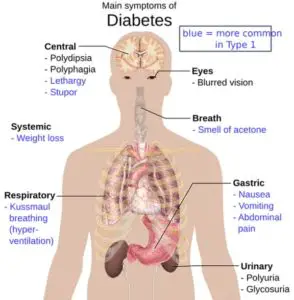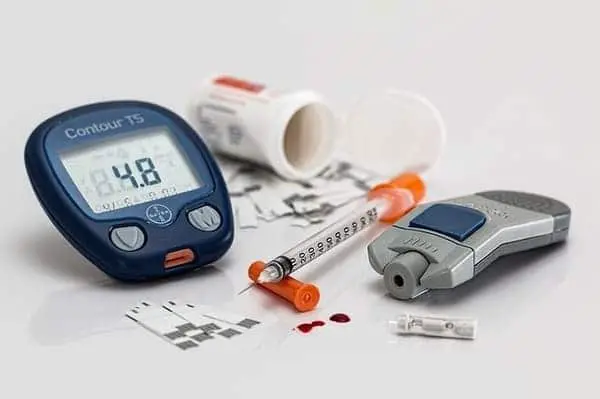Diabetes is, unfortunately, a common health condition faced by many Americans today, and people of all ages, races, and socioeconomic backgrounds deal with this life-altering medical situation. For diabetic interstate truck drivers, the difficulties of coping with diabetes can be even more demanding than they are for most who deal with diabetes.
Recent good news for diabetic truckers, though, brings some relief to the formerly troublesome regulations that have haunted commercial drivers as they endeavored to follow the legalities of being a diabetic commercial motor vehicle (CMV) operator. There are also daily measures that truckers can take to better manage this medical disorder.
In 2015 the diabetic population in the United States was estimated to be about 30.3 million. This number reflects those that were officially diagnosed and those that were not.
Add to this staggering number the fact that truck drivers are 50% more likely to develop diabetes than the average population, and it is simple to conclude that truck drivers and diabetes often ride together.
What is Diabetes?
The hormone insulin is made by beta cells in the pancreas and is necessary for the body to move glucose (sugar) from the bloodstream into the body’s cells so that the cells can then have energy. Diabetes, also called diabetes mellitus, is a disease in which the body’s ability to produce or effectively use insulin is impaired. As a result, there is an abnormal metabolism of carbohydrates with an elevated amount of glucose in the blood and urine. Diabetes presents itself primarily in two ways: Type 1 or Type 2. Both Type 1 and Type 2 can result in hyperglycemia (high blood glucose) and hypoglycemia (low blood glucose).
 Type 1 diabetes means the body cannot produce insulin on its own. When the body doesn’t make its own insulin, then the diabetic must have insulin therapy, which means the person must inject the hormone into his or her body. Without the treatments the patient will eventually die. Sometimes referred to as juvenile diabetes, there are approximately 1.25 million Americans of all ages that have Type 1 diabetes.
Type 1 diabetes means the body cannot produce insulin on its own. When the body doesn’t make its own insulin, then the diabetic must have insulin therapy, which means the person must inject the hormone into his or her body. Without the treatments the patient will eventually die. Sometimes referred to as juvenile diabetes, there are approximately 1.25 million Americans of all ages that have Type 1 diabetes.
Type 2 diabetes is the more common form with almost 30 million Americans suffering from this insulin impairment. With Type 2 the body produces insulin but is not able to use it properly. This is sometimes referred to as insulin resistance. Most often the blood glucose level rises, and the glucose cannot be transported normally to the cells. The cells then become starved. In time, or sometimes quickly, permanent damage may be done to the eyes, kidneys, heart, or nerves.
Type 2 diabetes can be controlled with lifestyle choices and sometimes oral medications or insulin injections. Unlike Type 1 diabetes, Type 2 can be drastically improved by healthy eating, exercise, and maintenance of the necessary medications
Obviously, diabetes is a disease that demands attention. Diabetics cannot survive without medical and lifestyle interventions. Because of the severity of the effects of diabetes the regulations in the past have been extremely strict for diabetic truckers. Now, however, changes to the regulations concerning diabetic truck drivers make it much easier for these truckers.
New Regulations for Diabetic Commercial Truck Drivers
In the fall of 2018 the Federal Motor Carrier Safety Administration (FMCSA) revised the regulations that had been imposed on diabetic truck drivers since 2003. The new regulations, effective November 19, 2018, now make it much simpler and more cost-efficient than the previous laws governing diabetes and CMV operators.
The revisions are applicable for certain diabetic truck drivers that can maintain a stable insulin program and that can prove through their treating medical provider that their diabetes is properly controlled.
The new regulations can be broken down as follows:
- The truck driver with insulin-treated diabetes mellitus (ITDM) works with his or her healthcare professional who prescribes and manages his or her insulin program.
- For the ITDM driver, the healthcare professional gives to a certified medical examiner (CME) the Assessment Form: MCSA-5870. This form is verification that the CMV operator enforces a stable insulin regimen with proper control of his or her diabetes.
- The assessment form is granted when the ITDM driver provides the healthcare provider with at least 3 months of self-monitored blood glucose records. If 3 months are not available, then the driver can obtain a provisional certificate for up to 3 months while the necessary documentation is gathered.
- The previously mentioned “certified medical examiner” refers to ones listed in the National Registry of Certified Medical Examiners.
- The CME decides if the ITDM truck driver meets the FMCSA’s physical qualification standards for operating a commercial vehicle.
- If the CMV operator qualifies, then he or she is cleared to maintain an active commercial driver’s license (CDL) for the next 12 months and does not have to go through the former lengthy and costly exemption process.
Regulation Improvements, the New versus the Former
The new regulations are much more practical than the former rules, and this is accomplished without endangering the safety of either the ITDM drivers or those who share the highways with them. Now diabetic truck drivers can better focus on maintaining their medical situations without the added stress of jumping through endless government hoops to keep their CDL.
The following gives a summary of past regulations for diabetic truckers driving interstate.
- Before 2003, there was a mandatory ban on ITDM truck drivers being allowed to drive interstate.
- From 2003 until 2005, truck drivers with ITDM had to apply for exemption in order to keep the their CDL. This required a driver to prove he or she had been driving commercially for a 3 year period in which he or she had been on insulin but with no episodes.
- Then in 2005 the regulations were modified so that Type 1 diabetics had to be on insulin for 2 months and those with Type 2 had to be on insulin for 1 month. For both, their driving records were closely monitored to make sure the insulin was not affecting their road performance. The drivers also had to become a part of a diabetic monitoring program.
- The FMCSA had 180 days to review the ITDM driver’s exemption application. This process was allowed to take longer if the information was incomplete or if more medical information was required.
- Then the decision of the FMCSA was posted in the Federal Truck Driver Registry, and the public had 30 days to make comments about the driver’s abilities to be a safe part of the highway. After these expressions of public opinion, the FMCSA would make a final decision, and the ITDM applicant would receive the decision in the mail.
Besides the new simplicity, comparatively speaking, of the regulation revisions, there are economic impacts for the ITDM truckers and their families. The approximate savings for the 5,000+ drivers this affects comes to about $5 million a year, in relation to the amount paid in recurring costs by these drivers to stay in the diabetic exemption program. Also, in terms of the time and opportunities wasted while ITDM truckers waited in the stages of the diabetic exemption program, there will be a savings of $215,000 each year.
What a relief the new regulations are for truck drivers that are already burdened with maintaining a healthy lifestyle on the road! No longer are these extreme measures required, and now many capable truck drivers have a new freedom to apply themselves more fully to an already demanding career choice.
Truckers-50% More Likely to Develop Type 2 Diabetes
Why are truck drivers so much more prone to developing Type 2 diabetes? It’s partly about lifestyle choices on the road, some of which can’t be changed but some of which can be.

The common risk factors for developing Type 2 diabetes include a family history of diabetes, smoking, high blood pressure, physical inactivity, being overweight, and poor eating habits. Except for the family history, these are health aspects that can be at least somewhat controlled.
Yet, life on the road works against overcoming these factors. Fast food is just that, quick and easy and often the seemingly most economical. Most often, though, fast food is not the healthiest, and daily consumption of these processed, high-in-fats and low-in-nutrients, foods can lead to obesity and high blood pressure.
The very nature of long-haul driving reduces the amount of time the driver has for robust physical activity. Hours spent behind the wheel certainly make the CMV operator tired, and the stress of keeping schedules and meeting deadlines drains the energy right out of the trucker. It’s difficult to muster a desire for vigorous activities once the day’s driving is done.
Unhealthy foods, high stress levels, absence of physical activity, and lack of normal sleep all have adverse effects on the body. Oftentimes, these negative components are all that are needed to plunge the CMV operator into Type 2 diabetes.
Healthy Choices for the Truck Driver
All is not lost! There are measures the truck driver can take to preserve his or her health on the road. It hinges on personal choices and determination. Being diligently proactive is a necessity!
Health Education Specialist Kay Pfeiffer spoke at the 2018 Mid-America Trucking Show, comparing “diabetic professional truck drivers who are not testing their blood sugar with ‘driving at night without headlights, and you’re going to crash.’”
Other than testing his or her blood sugar regularly, the CMV operator also needs to keep medical appointments. Following through with needed medical visits is crucial to maintaining a stable insulin regimen. Even while on the road, there are helpful options for the ITDM driver, including a network of clinics specifically for truckers that is springing up across the nation.
In some areas wellness clinics are also provided by CVS and Walmart. In planning the trucking route it’s always a great idea to do a bit of homework and be aware of which towns and cities offer these helpful wellness centers.
 Another potentially life-saving practice is to wear a medical bracelet and to keep a file of the CMV driver’s medical history on board the truck. This file can be either a hard copy or an electronic file, or both may be readily accessible to medical providers in case there is an emergency while the trucker is on the road, far from home and loved ones.
Another potentially life-saving practice is to wear a medical bracelet and to keep a file of the CMV driver’s medical history on board the truck. This file can be either a hard copy or an electronic file, or both may be readily accessible to medical providers in case there is an emergency while the trucker is on the road, far from home and loved ones.
As often as possible, truck drivers need to make healthy food choices for a well-balanced diet. The American Diabetes Association is one place to find diabetic-friendly food suggestions, the best being ones that have a low glycemic index. Healthy choices include beans, sweet potatoes, whole grains, leafy green vegetables, berries, and certain other fruits. Packing snacks and already-prepared meals from home takes more effort, but these foods are also much more healthy.
Staying hydrated, especially with water, is also crucial to a healthy diabetic diet. Again, having a plan ahead of the road trips helps.
Any physical activity, however small, is a plus to the trucker’s health. At each stop a short walk, even if it’s only 10 minutes around the parking lot, can make a great difference over time. If there are 3 or 4 stops each day, then this will provide 30 or 40 minutes of walking, which is one of the best low-impact exercises for anyone.
There are apps available to assist the trucker in finding walking parks or even hiking trails in towns and cities along the way. This is especially beneficial to long-haul drivers who are on the road for days at a time. Having safe, easily accessible places to walk will add pleasure and relaxation to an otherwise stressful job. Here are two such apps, but there are others available online:
- https://www.nrpa.org/our-work/park-path-app/
- https://www.traillink.com/Mobile-Apps/?gclid=EAIaIQobChMI66Hynqr63wIVmYzICh2fBwS-EAAYASAAEgKR5PD
Why Bother?
The new revisions to the regulations that govern the lives of ITDM truck drivers have now made obtaining and maintaining a CDL much simpler and more practical. Yet, there are still situations that can cause the trucker to lose his or her truck driving license.
If a trucker has a severe episode, then the episode must be reported to his or her medical provider. The trucker is then banned from driving until the health care provider determines the driver’s insulin regimen has been stabilized.
A severe episode refers to a situation in which the trucker experiences a hyperglycemic (high glucose) or a hypoglycemic (low glucose) level and requires the assistance of others. This includes, but is not restricted to, losing consciousness, having a seizure, or going into a coma.
In Conclusion
Being proactive for his or her own diabetic health is of extreme importance, if the commercial truck driver is going to survive on the road. Diabetes is a life-changing condition, but with personal diligence and with the network of support that is available, both on the road and legislatively, the trucker can overcome these drawbacks. Then they will be nothing more than a bump in the road of successful truck driving.
